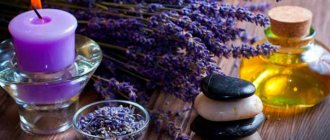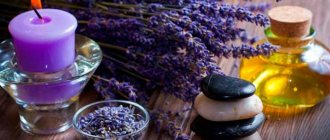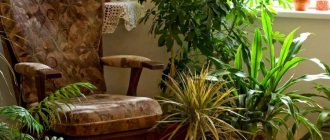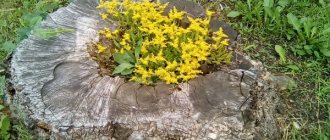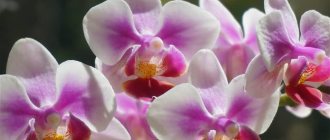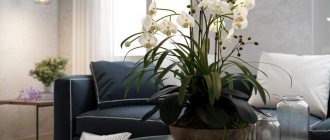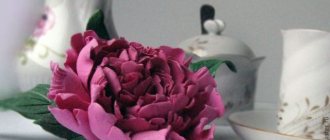According to the ancient Chinese teachings of Feng Shui, a person should live in harmony with the world. In order for internal energy to interact beneficially with the energy of things, you need to be able to properly plan space.
In addition to arranging furniture and interior items, followers of geomancy recommend taking a responsible approach to choosing places to place living plants. According to Feng Shui, flowers for home well-being should be purchased with love, placed in suitable rooms and provided with regular care.
General rules for growing house plants according to Feng Shui
What rules should you follow when choosing and growing indoor plants?
- At the stage of selecting plants, you need to pay attention to the sprouts: it’s good if they are directed upwards. These plants are perfect if you want a positive atmosphere to reign in your home. It is believed that plants with drooping sprouts, on the contrary, attract negative events and are a kind of “energy vampires”;
- if we talk about the shape of the plant, then round leaves are preferable, sharp ones bring negativity;
- In Feng Shui it is believed that plants are divided into male and female. Therefore, it is especially important to place plants that are suitable for the owner of the room based on gender;
- It is not recommended to place dry plants in the house. If you like ikebana, give it a separate space in your summer cottage;
- Do not place too many plants in the bedroom, in particular, near the bed;
- Feng Shui experts believe that large plants have more powerful energy than small ones. Therefore, in cases where you urgently need to change the atmosphere in the house, it is recommended to choose large flowers;
- Most often, negative energy accumulates in hard-to-reach places: corners, shelves, storage rooms. This is where it is recommended to place plants to restore a harmonious atmosphere;
- Especially moisture-loving plants should be planted in red pots.
Folk signs
- Do you have a cactus at home? Then don’t hope that your unmarried daughter or granddaughter will get married. This is only if the cactus lives in the bedroom. Unmarried women should also beware of the plant. If you believe this superstition, then your man suffers from alcoholism because you have a cactus at home.
- If you were given a palm tree as a gift, do not keep it at home. As it turns out, this plant can only attract misfortune.
- Ivy has proven to be a harmful air purifier. Because he won’t let anyone near his owner. According to popular belief, ivy drives men out of the house.
- Believe it or not, according to popular belief, Violet brings failure in love affairs to young girls.
As you noticed, there are quite a lot of signs about flowers. They are positive and negative. If, for some, the plant can serve as good luck, but for others it can become a symbol of bitterness. However, you shouldn't worry about such things. After all, if you live by believing in only signs, then you can live at all. The main thing is that you need to choose everything according to the principle: “The main thing is that I like it!”
How to place indoor plants in your home according to Feng Shui
By understanding the patterns of flower placement according to Feng Shui, you can skillfully control the energy flows in the room. Houseplants can block the negative effects of Sha energy or stop excessively intense Qi energy. If the Qi flows are too powerful, it can negatively affect the atmosphere. Sha energy originates where there are too many sharp corners. Plants will help minimize the effect of negative flows in your home.
Feng Shui includes 5 basic elements: Fire, Water, Earth, Wood and Metal. Each of the elements has specific characteristics and, accordingly, each requires individual space in the house. Plants belong to the Wood element, so the most successful option for their placement is the east side (or southeast). In Feng Shui, a tree symbolizes financial and life well-being, the realization of dreams, health and personal growth.
But there are flowers that are classified as other elements. For example, purple, pink, and red flowers belong to Fire, which is why the southern sector is considered the most successful location. Shades play a huge role in the science of Feng Shui, so it is recommended to pay close attention to the color of the plants you choose and their future location. When flowering starts, it is worth moving the Fire plant to the southern part of the room. This will activate the Chi energy and improve the atmosphere of the southern sector. The location of the plant can affect its effectiveness. Therefore, it is necessary to carefully place flowers around the house:
- It is recommended to place plants only in their appropriate parts of the house. It is recommended to plant a money tree in the wealth zone. In any other zone it will lose its effectiveness;
- in the bedroom you should adhere to the principle “the less the better,” especially near the bed;
- Do not place pots between doors or between a window and a door. This location is considered unfavorable;
- You should not plant thorny plants where you rest: they can interfere with the restoration of vital energies. Placement in the southwestern sector is not recommended: it may adversely affect personal life;
- Fruiting and flowering plants are perfect for the kitchen;
- for the western sector, white flowers will be the best choice. Such placement will ensure understanding and harmony between generations and create an ideal atmosphere for creativity;
- It is recommended to place cacti in the northern sector of the house.
Favorable plants for the home according to Feng Shui
In order for the plant to act as efficiently as possible, it is necessary to choose it rationally in accordance with individual needs and the location where you plan to place the flower.
Azalea
This plant can be an excellent donor of creative energy. If you constantly feel tired and exhausted, it is worth understanding which plants will restore vigor and vitality. Azalea will give a “second wind” and inspiration to those people who are tired just after waking up. Azalea revives its owner and develops empathy. The subtle aroma of the flower provides concentration, the ability to focus on what is important and ignore the less significant. Physically, it helps improve the condition of the cardiovascular system and improves blood circulation. You should be very careful and caring with azalea.
Guzmania
This green plant has long, thin leaves. Guzmania provides a good mood and prevents depression. It is recommended to place the flower in the eastern or southwestern parts of the house. Guzmania gives peace, tranquility, harmony in relationships, the red color helps to retain love feelings. A yellow flower will provide financial enrichment and good luck. By placing a diploma next to Guzmania, you can become more successful in the professional field.
Calla lilies
According to Feng Shui, different plants perform different functions. Callas protect the house in which they are located. They help preserve love in marriage, give youth and external attractiveness. This plant will help get rid of stress and encourage you to take important actions. Not only the flower itself, but the image with it, is endowed with powerful power.
Crassula
This plant is called the money tree, which has power. Crassula can influence financial well-being, giving success in all areas. It is recommended to place these flowers in the south-eastern part of the house. It is best to grow a tree yourself so that it feels the love of the owner and recognizes the atmosphere of the room. You can place coins or ribbons on it, placing it on a red or purple napkin with hieroglyphs denoting financial well-being.
Plumeria
A tree of incredible beauty, with a subtle heavenly scent with white-yellow and crimson petals. The plant symbolizes eternal life and victory over death. In Thailand, it is customary to place the plant near holy places and churches. The tree has gained great popularity in Hawaii and is endowed with a sacred meaning. It is recommended to place plumeria on the south side of the room; the tree is perfect for the bedroom. In addition to its aesthetic characteristics, the plant has the ability to give home owners health and prosperity.
Nematanthus
The Brazilian shrub produces beautiful orange flowers. Placed in an apartment, Nematanthus plants will ensure the health of other green friends indoors. Planted near nematanthus, even seriously ill plants get a chance to recover. A friend from Brazil will give a person health and mental balance, as well as financial prosperity. The most important thing is to provide the plant with care so that it remains in good condition.
Violet
Violet is associated with Yin energy. The flower attracts financial well-being and physical health. Red pink flowers give vitality, and white flowers give peace and confidence in the future. Blue flowers provide motivation and inspiration.
Geranium
The aroma of the plant provides a calming effect, relieves stress, gives success in endeavors, good luck in all areas of activity. The flower is related to Yin energy. The smell of geranium repels insects. It is not recommended to place geraniums where the owners are most often.
Begonia
If you often have guests, begonia will prevent negative energy flows from entering the house. The room will be filled with beneficial energy.
Ficus
The tree will relieve negative emotions and aggressive manifestations and give peace. Capable of imparting energy, concentration, and enthusiasm. Drives away depression. It is important to know that it is not recommended to place a ficus in the marriage zone: located in this sector, it can spoil interpersonal relationships.
Date palm
Often grown from seed. This plant has positive energy and brings happiness to the room and family members. Helps you focus on what is most important, relieves you of sadness and negative emotions, and gives you hope for the best.
Ferns
Perfect for rooms with negative energy, as they feed on negative currents. It is not recommended to be placed in a room with a sick person.
Chrysanthemums
They promote advancement at work, in particular, improve relationships between partners. Great for offices and work areas.
cacti
Many people believe that cacti carry negative energy, but with a rational approach they can rid the room of electromagnetic waves. They are beneficial when placed next to technical devices. If you plant a cactus on the windowsill, it will prevent theft in the house.
dollar tree
Gives financial well-being. Feng Shui experts advise planting a tree yourself by placing coins at the bottom of the pot. When the tree grows, you need to wrap the branches with ribbons and coins and place the pot in the southeast zone.
Citrus
They have a good influence on children: they help with their studies and promote the development of mental abilities. Perfect for a children's room.
What types of house flora are best not to keep at home?
Chinese folk teaching also talks about plants such as “bloodsucking plants,” which include exclusively prickly representatives of the green world. To prevent them from causing harm, they are placed near computers or on the windowsill.
In addition to everything, dried and wilted flowers in the house according to Feng Shui absorb the vital energy of Qi and are spreaders of germs! If you see a wilting flower at home, the shoot should be cut off and all remaining parts thrown away.
In addition, do not bring home flowers that were given to you by people with heavy energy. Since their aura can negatively affect the home atmosphere and the well-being of household members.
These plants should not be kept at home!
Dieffenbachia
This plant is beautiful, with its juice, which, unfortunately, is not beneficial for people, but on the contrary can cause irritation on the skin or burn the retina. It should not be kept indoors, especially for those who have small children. Because if a large amount of juice gets into your mouth, a severe burn may occur.
Oleander
A flowering plant that smells strongly while in bloom may even cause you to faint. Just like Dieffenbachia, its juice can cause blindness due to a mucus burn. Other green friends of the plant have similar effects: Pachypodium, Dipladenia, Periwinkle, Adenium.
Monstera
One of the bright and frightening vampire plants. The monster needs, even needs to evoke fear, horror, and simply attract attention. This plant “feeds” on strong emotions and feelings. The plant is endowed with both disadvantages and advantages: it perfectly cleans the air of dust and carbon dioxide, and releases oxygen. But it also takes energy away from people. Therefore, florists advise storing the plant for those people who are phlegmatic and melancholic. Temperamental choleric people, on the contrary, will have a hard time next to a monstera. After all, they lose their peculiarity by splashing out energy on others. Therefore, it is better for impressionable and often sick people to keep other plants at home.
Fern
Ferns are “guests” from tropical countries. These beautiful green inhabitants are popular in our latitudes. Ferns are one of the strongest energy absorbers. Like Monstera, it absorbs human energy.
Hibiscus
Hibiscus is considered a vampire plant that absorbs energy with lightning speed. This is due to the fact that the plant grows very quickly. And it is also at the moment of flowering that hibiscus consumes maximum energy. But it is worth noting that Hibiscus will certainly attract everyone’s attention with its lush and beautiful flowering.
Thuja
Popular garden flower. In the room, Tuya absorbs all the energy entirely. Lethargy and drowsiness can become your eternal companions. I don't think you would keep such a plant at home.
Shy Mimosa
A strange plant, with a thin stem and small leaves. The leaves of this plant are fragile, and if you touch the leaves with your hand, they supposedly hide and curl into a tube. Fear! With prolonged contact with Mimosa, you can lose your hair.
Ivy evergreen
Poisonous berry plant from the Araliaceae family. Looks like a vine bush. Due to the toxicity of the fruit, it is not recommended to keep this green plant at home.
Adenium
It looks like a beautiful plant. It has thick stems. At the very top of the plant there are thin leaves and pink flowers. Its juice is harmful and toxic, and poisoning of the body can occur.
Croton
From the Euphorbiaceae family. An elongated small tree with spotted leaves. Its petals are invisible, and it blooms extremely rarely. The liquid of this plant provokes the appearance of skin diseases. The poison, once in the blood, can be fatal.
Philodendron
From the Araceae family. Philodendron has lush greenery. Echidous, like Croton. It is advisable not to come into contact with this toxic substance, as it can cause blindness.
Stellera dwarf
A medicinal flower that should be used under the supervision of a specialist. A tall stem, which consists of twenty or thirty dotted spots of white color. Once in the human body, it can deprive the voice.
Nightshade
Flower with bright orange fruit. These fruits are extremely evil and dangerous to humanity. The bright color of the berries attracts the attention of children and pets, which is precisely why you should not keep such a flower at home.
Trichocereus
A relative of the cactus, as it is very similar in appearance to it. External description: long and large needles, blooms with large light flowers, also smells pleasant. Trichocereus contains toxins that can paralyze nerve endings.
Gesner Tulip
A well-flowering plant with a medium-sized stem. There is a small flower in the center. The color can be varied, ranging from light tones to variegated and bright. One of the disadvantages is hair loss and baldness.
Tuberose
A perennial plant whose stem reaches a height of almost 50 cm. It has a strong and sweet smell. Tuberose subdivides microelements that enhance the sense of smell. This power of the plant is also used in medicine. As it turned out, foreign doctors used the flower as a medicine when patients lost their sense of smell due to nerve problems. It is not advisable for anyone with heart problems to have this flower in their home. The aroma of this plant can cause weakness and loss of energy.
Sansevieria
The plant is very interesting in appearance, one might even say strange? Something like the tail of a fish. For this reason, it has a second name, “pike tail”. The green flora blooms and has a delicious aroma. It has a beneficial effect on the clean air of the house, as well as on its aura. However, if you believe ancient and ancient signs, it has a bad effect on personal life, and the owners may remain alone for the rest of their lives.
Artificial flowers in feng shui
Feng Shui believes that all house plants carry a positive charge. It is only recommended to avoid poisonous flowers and dried plants. Plants that have dried out take away energy and vitality. Artificial flowers are in no way inferior to real flowers in effectiveness.
Feng Shui experts believe that artificial specimens have positive energy and are perfect for those sectors where it is not advisable to place fresh flowers. For example, a wet bathroom or areas close to fire can be lethal to living plants. In this case, the use of artificial specimens may become relevant. It was stated above that it is recommended to place as few living plants as possible in the bedroom: this is due to the fact that a sleeping person is vulnerable to the rotting processes that occur in plant pots. Therefore, artificial plants are great for the bedroom. Feng Shui supports the idea that artificial specimens are relevant for wet rooms, the head of a bed or in the kitchen. The most powerful flowers in terms of energy are: peony, orchid, magnolia, chrysanthemum and lotus.
Location for anthurium
Let's consider where you can put anthurium. The best place for the flower will be on the east side of the house. If you choose between rooms, then the living room and bedroom are suitable. It is best to place the anthurium in a well-lit room, but without direct sunlight on the plant. Of course, you can keep it in a dimly lit place, but in this case the anthurium will not bloom.
Important! It is prohibited to place the flower near electrical appliances. They absorb the energy of the flower.
Images with flowers in the teachings of Feng Shui
The science of Feng Shui interprets drawings with flowers and paintings as unique portals that can endow the room in which they are located with powerful energy. Indoor, forest, and mountain plants are great for images placed in living rooms, guaranteeing a flow of happiness and good luck. Each flower is endowed with a hidden meaning:
- peonies and poppies will give an important meeting, and provide understanding and harmony to the married couple;
- lotus guarantees authority, respect and well-being;
- white lily and lily of the valley symbolize purity and balance in the home;
- an orchid guarantees mutual understanding and many children;
- chrysanthemum balances the heart and mind;
- Roses give life to positive energy and give prosperity in love.
For paintings depicting flowers, the southwestern sector of the room is best suited. If you need to restore mutual understanding in a married couple, it is better to hang a picture in the bedroom. When you need to improve relationships between family members, it is worth placing the picture in the living room, between employees in a team - in the office. It is rational to place an image with a plant favorable in Feng Shui exactly where it is necessary to restore harmony and agreement.
Is it compatible with spathiphyllum?
In the house, next to the “male” flower (anthurium), a spathiphyllum is placed, which, according to popular belief, is recognized as a “female” plant. The composition symbolizes the union of female and male happiness, harmony in family relationships. Shrubs with white and bright red buds framed by dark green foliage organically complement each other.
You can care for anthurium at home together with spathiphyllum. Shrubs have similar inflorescences and root systems, because... They belong to the Arodny family and come from the tropics.
Flowers are propagated by dividing the bush when transplanted into wide tubs. According to the teachings of Feng Shui, you can give shoots to friends, acquaintances, and relatives.
Planting spathiphyllum and anthurium together harmonizes the relationship of the established couple. Each spouse is recommended to care for the plant - male or female.
